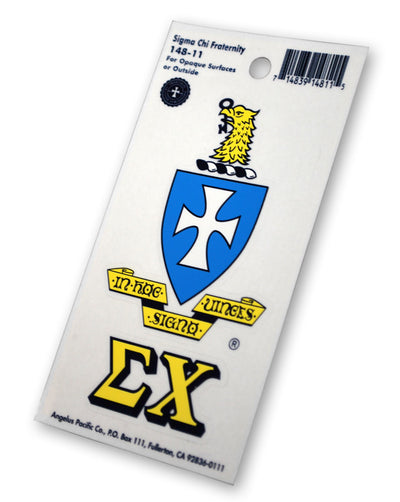The History and Meaning of a Sorority Lavalier
The ritual of lavaliering is rooted in Greek tradition and is an important part of both sorority and fraternity life in the United States. The lavalier has long been considered a fundamental right-of-passage for many college couples, with the lavalier acting as a symbol of the couple's commitment to one another. Despite the ritual's relative lack of popularity on modern-day college campuses, it still has special meaning for many long-term couples and is often seen as very romantic, exemplifying old-fashioned values. If you're looking to learn more about what is lavaliering in fraternity and sorority life, keep reading.
The Greek Organization Lavalier Explained
Most major colleges across the United States offer the opportunity for students to join a Greek letter organization, known as a fraternity or sorority. Female undergrad college students join a sorority, while male undergrads join a fraternity (there are some female fraternities and co-ed organizations as well). These organizations are akin to a family and are usually represented by Greek letters.
Each sorority and fraternity has its own set of traditions. One of longest-running traditions is known as lavaliering. The lavalier is an esteemed way for a collegiate couple to express commitment and love for one another. A lavalier is a necklace featuring a pendant made up of the male partner's fraternity's letters.
The male partner presents his female love interest with a lavalier necklace featuring the Greek letters of his fraternity. The presentation of a lavalier necklace symbolizes a long-term commitment between the collegiate couple. The lavalier necklace and its pledge also gives the female partner honorary rights to the fraternity. Giving a lavalier to a partner is considered a serious commitment, almost as serious an engagement.
Lavaliering is an important step in showcasing a male's devotion to a fraternity. Essentially, he is pledging both himself and his partner to the fraternity family. The lavalier is generally viewed as a lead-up to an engagement, much like a promise ring or other piece of jewelry.
The Lavalier Necklace
The necklace was popularized in early 1900 by Duchesse de la Valliere, a well-known mistress of King Louis XIV of France. The suspended pendant style of the lavalier fraternity necklace became incredibly famous during this time. Modern lavaliers have a similar style to the one designed by Duchesse de la Valliere.
Today, lavalier medallions feature the fraternity's Greek letters. You may see lavaliers for fraternities like Sigma Chi, Kappa Sigma, Phi Delta Theta, Sigma Alpha Epsilon and others. Three Greek letter pendant typically hangs from a sterling silver or gold chain that rests along the woman's breastbone. Lavaliers are typically very simple and only include the group's Greek letters in a simple metal finish.
The Lavalier Ceremony
Many times, lavaliering is preceded by "pinning." The fraternity member gives his girlfriend a pin, which represents his commitment to her. Then, once the relationship becomes more serious, he will give her a lavalier.
The ceremony surrounding the presentation of a lavalier necklace is a big deal for most fraternities. The male must first request permission from his fraternity family to make a lavalier pledge to his love interest. Once this permission is granted, the ceremony will take place. Typically, at this point, the members of the fraternity have had a chance to get to know the female partner and they readily grant their permission. The request also gives the fraternity brothers the opportunity to express any concerns they have about the relationship in an effort to look out for their brother.
All the fraternity brothers gather to witness as the necklace is ceremoniously presented to the female. This may be a stand-alone event or may take place as part of another fraternity event.
The female sorority house also holds a special ceremony of its own to both announce and celebrate lavaliering. The sorority sisters gather in a circle and pass a lit candle around. Once the candle reaches the lavaliered sister, she will make her announcement and blow it out. The ceremony is a highly important part of the process, as being lavaliered is considered an act of grace by both the fraternity and sorority.
The Rules of Lavaliering
Basically, the lavalier is a well-known as a steppingstone between dating and the long-term commitment of engagement. If a male intends to offer a lavalier necklace to his partner, there can only be one woman he offers this necklace to. He cannot make a lavalier pledge to more than one woman, so he must carefully consider who he makes the pledge to.
The lavalier pledge must be kept a secret by the female until the candle tradition is held by her sorority house. Usually, the candle ceremony is held soon after the lavalier pledge ceremony. Ultimately, lavaliered couples are expected to become engaged after the lavalier pledge.
Looking for High-Quality Greek Organization Merchandise?
Looking for a lavalier necklace or other jewelry for your fraternity or sorority? Greek U offers everything from sterling silver lavaliers to gold rings and bracelets, plus high-quality, customized sorority gifts, clothing and accessories.
Check out our popular Sterling Silver Lavalier Pendant with Swarovski Crystal or our Bar Necklace.
We aim to represent your organization in the most fashionable yet affordable way possible. Get your gear at Greek U!










